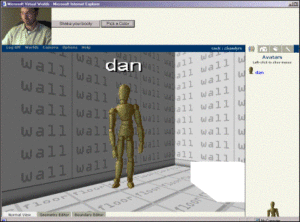
SEE VIDEO
This is a computer conferencing system for watching movies. Many people may be watching or listening to the same linear media but only the comments of other people viewing a frame close in time to the frame you are viewing will be displayed prominently. Other comments blur in the periphery. Each person has normal control over the movie (pause, fast forward, rewind) or they can slave themselves to another user’s control.
This software associates a person’s comments with the given moment in the linear media that they were viewing when they made the comment and sends the comment out over the network. The software then filters comments coming in over the network according to how close they are chronologically or thematically to the frame in the linear media that the user is watching. The association works both ways. People who are experiencing the same moment of a clip would naturally be more interested in each other’s comments. Conversely people who like talking about a particular topic might want to be represented by a particular moment of the clip.
This is an improvement over techniques like chat rooms, channels, or threads in conventional conferencing software because: 1. the users form groups without much conscious effort by merely showing a preference for one part of the media to watch and; 2. because associations are along a continuum without the discreet boundaries of chat rooms, channels and threads.
Technical Notes: I wrote this in Macromedia Director/Lingo exported to Shockwave and networked it using the Macromedia�s Multi-user server. NYU is pursuing a patent on this idea.

 heck it out at: http://comicable.com/
heck it out at: http://comicable.com/












